Key takeaways:
- Market volatility in cryptocurrency is influenced by speculation and emotional responses, making emotional control essential for investors.
- Developing a solid investment strategy, including predefined buying and selling thresholds, helps manage fear and anxiety during market fluctuations.
- Diversifying a cryptocurrency portfolio mitigates risks and creates growth opportunities while aligning investments with personal interests.
- Patience and community support are crucial in navigating the emotional challenges of investing, reinforcing the importance of continual learning from market fluctuations.
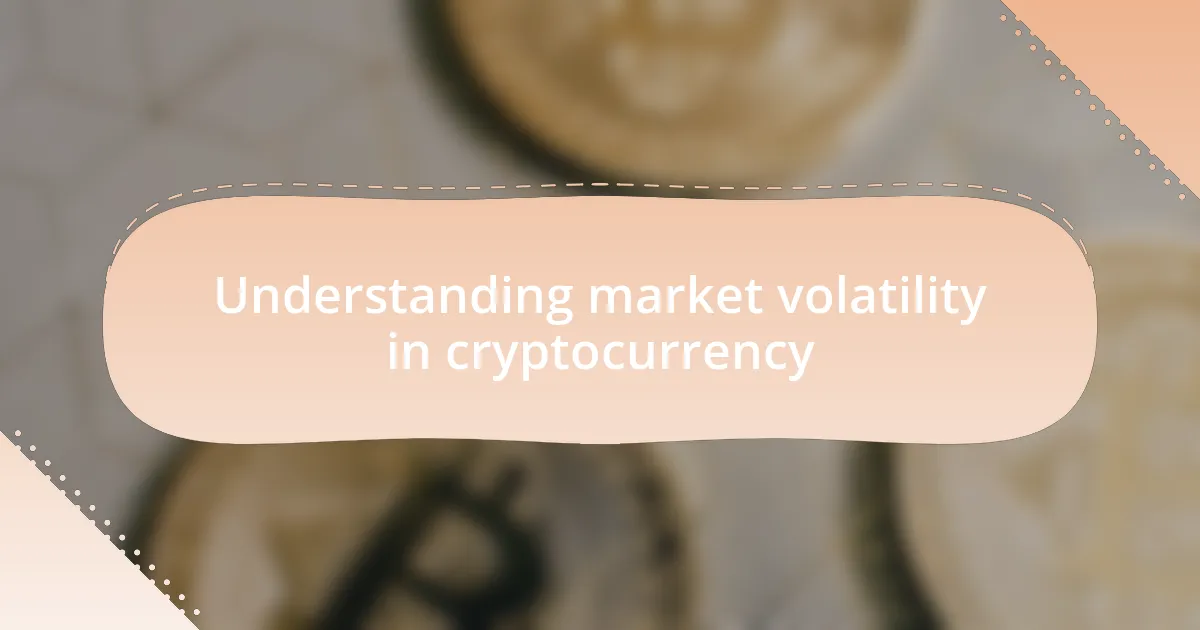
Understanding market volatility in cryptocurrency
Market volatility in cryptocurrency is both fascinating and intimidating. From my experience, I remember a time when the price of Bitcoin dropped over 30% in just a few days. It felt like a rollercoaster ride, where every twist and turn sent my heart racing and my mind spinning with doubts. How could something I believed in so passionately fluctuate so wildly?
Understanding this volatility is crucial for anyone looking to invest in crypto. Unlike traditional assets, cryptocurrencies are subject to rapid market movements influenced by speculation, news events, and even social media trends. I often find myself asking, “Is this a buying opportunity or a signal to panic?” Navigating these emotional waters requires patience and a solid strategy, which I learned the hard way after facing significant losses during a market downturn.
The emotional component of volatility can’t be underestimated. I’ve witnessed friends succumb to fear and sell off their investments in moments of panic, only to watch the market rebound shortly after. This teaches us that while volatility can be daunting, it also presents opportunities. Embracing this reality is the first step towards making informed decisions and maintaining a steady mindset in turbulent times.
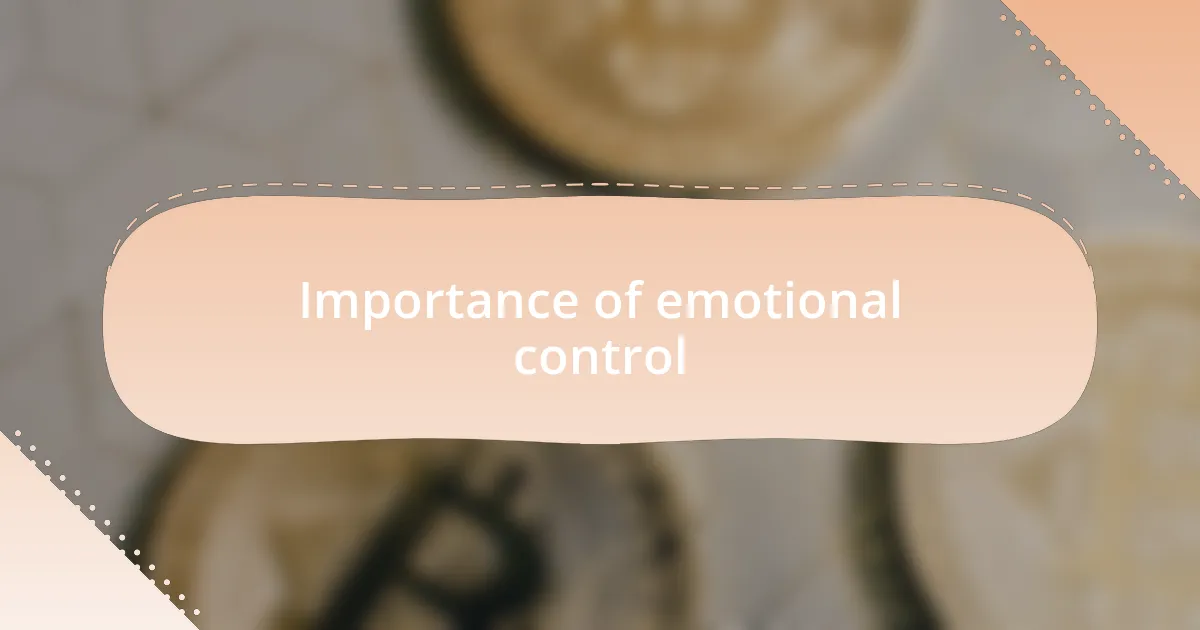
Importance of emotional control
Emotional control is essential when navigating the unpredictable waters of cryptocurrency markets. I remember feeling a rush of fear when the price of Ethereum plummeted overnight. It was tempting to let that anxiety drive my decisions, but I learned that if I allowed emotions to guide me, I risked making hasty moves that could lead to regret later.
Staying calm amid chaos doesn’t come naturally to everyone. After witnessing others panic-sell during a downturn, I resolved to create a personal strategy that prioritized emotional resilience. Have you considered how much your emotions influence your trading outcomes? I’ve found that maintaining a disciplined approach, paired with a clear understanding of my investment goals, can help diminish the impact of fleeting emotions.
When I stick to my plan and practice emotional control, I feel more empowered to face market changes. I recall a time I held on to my investments through a steep decline, convinced that my analysis was solid. The recovery that followed not only validated my decision but reinforced my belief in the importance of staying level-headed. In this volatile space, understanding the value of emotional control can truly make a difference in the long run.
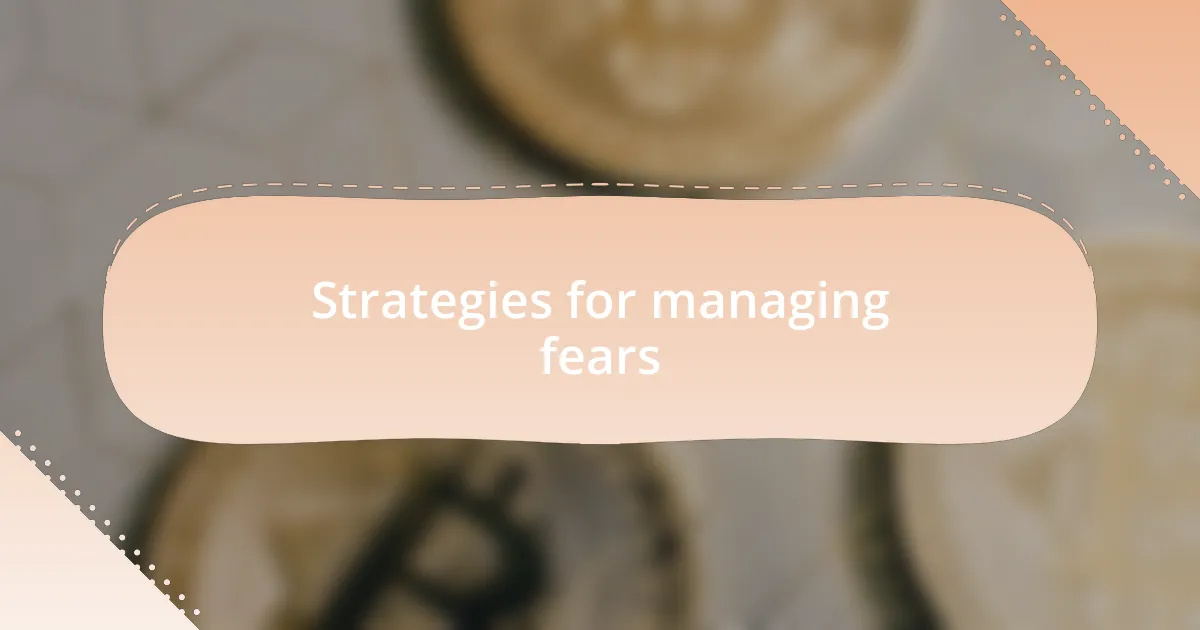
Strategies for managing fears
When I first faced significant market fluctuations, I quickly learned the importance of having a solid plan. It was one particularly turbulent week, and instead of panicking, I set predefined thresholds for buying and selling. This approach transformed my fear into a constructive framework, allowing me to make decisions based on logic rather than emotional reactions. Have you ever considered how much clearer your choices could be with a simple plan in place?
Another strategy I adopted involves regular reviews of my investment portfolio. Initially, those quick check-ins would send my heart racing as I saw the fluctuations, but I’ve since flipped that narrative. I now use those moments as opportunities to reassess my strategy and goals. For instance, during a recent downturn, I noticed that my long-term investments remained sound, which calmed my nerves. Isn’t it empowering to realize that market movements don’t dictate your success?
Lastly, I seek community support when anxiety creeps in. Engaging in discussions with fellow investors has been invaluable; sharing experiences and insights helps normalize my feelings and offers fresh perspectives. There was a time I hesitated to voice my fears, but once I did, I discovered I wasn’t alone. Have you tried connecting with others in similar situations? Often, the conversation can be a great remedy for fear.
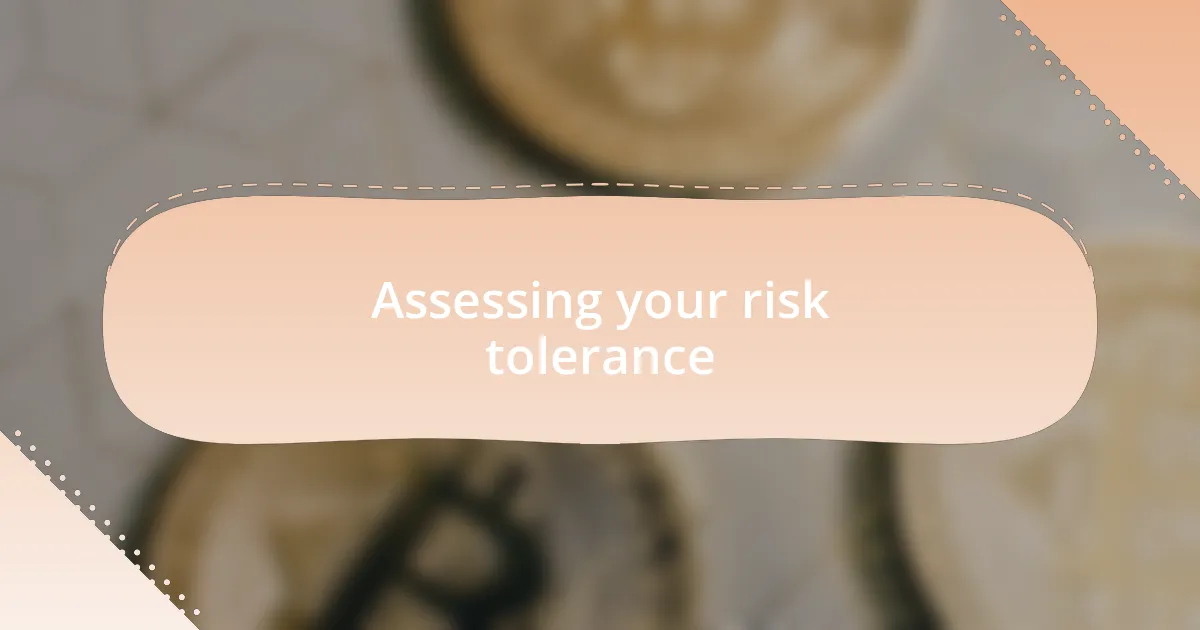
Assessing your risk tolerance
When I started investing in cryptocurrencies, I realized that understanding my risk tolerance was crucial. I remember sitting down one evening, reflecting on my financial goals and how much volatility I was willing to endure. It dawned on me that my comfort level wasn’t just about numbers; it was deeply tied to my overall financial situation and emotional resilience. Have you thought about what risks you can realistically handle?
To better gauge my risk tolerance, I used a simple exercise: I envisioned different market scenarios. I imagined how I would feel if my investments dropped by 20% or surged by 50%. Surprisingly, those exercises revealed a lot about my anxiety and excitement thresholds. It made me realize that while I enjoy the thrill of potential gains, I needed to prepare myself emotionally for the losses that often accompany them. How have you navigated your feelings about loss in your investment journey?
Adjusting my portfolio based on my risk tolerance has also been a game-changer. I distinctly remember shifting a portion of my investments into more stable assets during a particularly volatile period, which brought me significant peace of mind. That decision wasn’t just strategic; it was deeply personal, helping me to align my investments with my comfort level. Have you found that reevaluating your allocations can lead to greater confidence in your financial decisions?
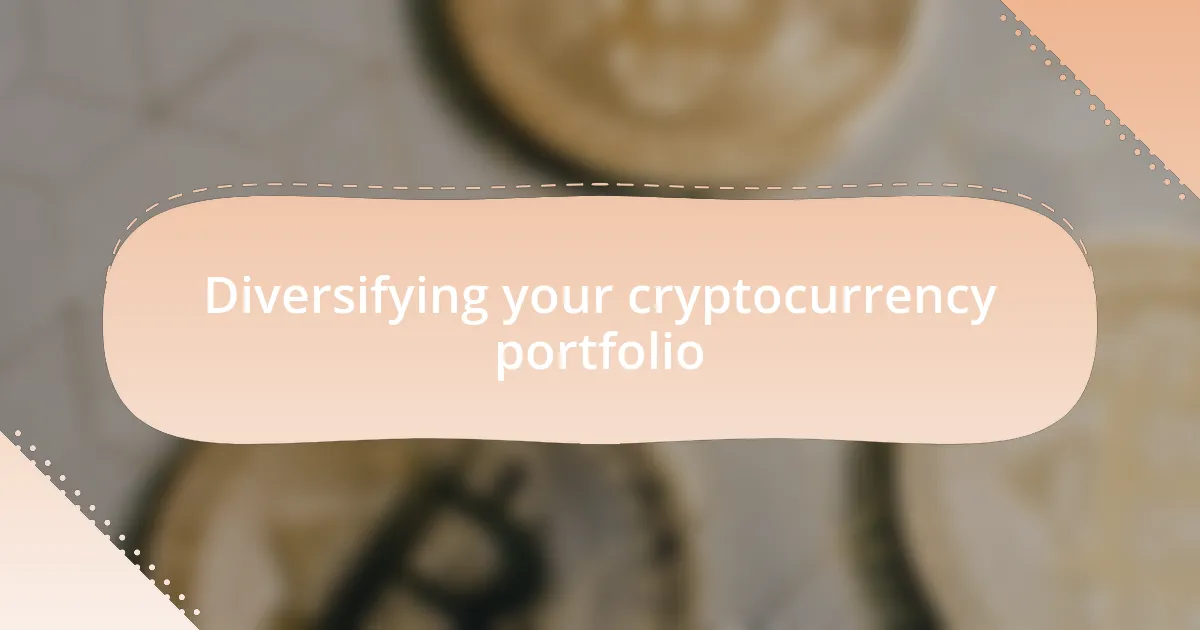
Diversifying your cryptocurrency portfolio
Diversifying my cryptocurrency portfolio was a turning point in how I approached investing. I began to realize that holding only a few assets could amplify my risks, especially during market downturns. By branching out into various coins and tokens, I not only mitigated potential losses but also created opportunities for growth. Have you considered how branching out might cushion your investments against sudden changes?
One memorable moment for me was when I decided to invest in lesser-known altcoins alongside more established options like Bitcoin and Ethereum. Initially, I felt anxious—what if these new investments plummeted? However, as I watched my portfolio grow in complexity, I started feeling a sense of control that I hadn’t experienced before. It became clear to me that taking calculated risks was part of the journey. What has been your experience with smaller projects in the crypto space?
I’ve found that diversification isn’t just about spreading investments; it’s about aligning my portfolio with my personal interests and beliefs too. Delving into sectors like decentralized finance and NFTs opened up exciting new avenues for me. This connection made me more invested, both financially and emotionally. Have you explored areas within cryptocurrencies that resonate with your passions?
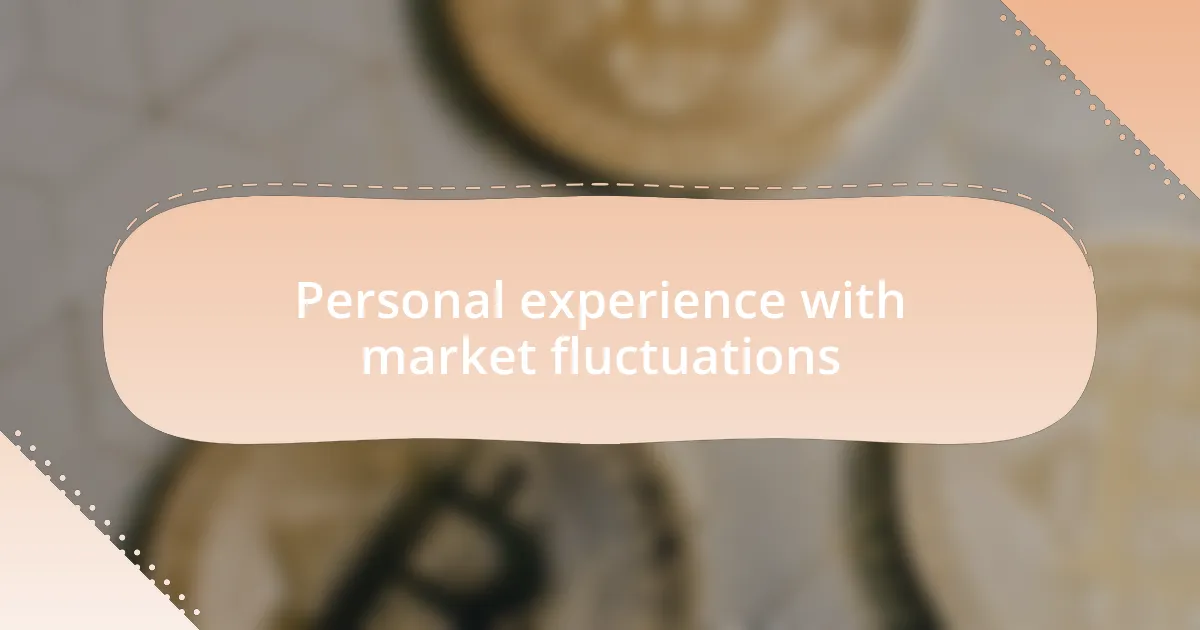
Personal experience with market fluctuations
Experiencing market fluctuations firsthand has deeply influenced my investment strategy. I remember the intense drop in early 2020; watching my investments plummet left me feeling vulnerable and uneasy. It was a true test of my emotional resilience, making me contemplate whether I should hold on or panic-sell. Have you ever faced that gut-wrenching decision during a downturn?
One day, after a particularly harsh dip, I took a step back and reflected on my long-term goals. I realized that my emotions were often guiding my decisions rather than a solid strategy. By adopting a more analytical approach—like reviewing historical trends and understanding market cycles—I found that I could navigate the highs and lows with greater confidence. Have you also discovered that shifting your mindset towards a more strategic view can ease the stress of volatility?
As I learned more about how market sentiment affects price movements, I became more adept at managing my reactions. Embracing volatility as a natural part of the investment process has transformed my outlook. It’s like riding a rollercoaster; once you accept that there will be ups and downs, the thrill of the ride becomes more manageable. How do you personally cope with the emotional rollercoaster of crypto investments?

Lessons learned from my journey
During my journey through market volatility, I’ve learned that patience is invaluable. There were moments when I felt tempted to jump ship during significant downturns, but staying the course often proved to be the wiser choice. Have you ever found yourself torn between impulse and discipline when the market shifts?
Another critical lesson was the importance of community and support networks. I remember joining online forums and engaging with seasoned investors who generously shared their experiences. Their insights helped me realize that I wasn’t alone in my struggles, and that camaraderie reinforced my resolve. How has connecting with others shaped your approach to investing?
Finally, I discovered the power of continual learning. Each market fluctuation presented a unique lesson, whether it was about recognizing patterns or understanding underlying market forces. This mindset of growth transformed my perspective—it’s not just about gains or losses, but about evolving as an investor. Do you view each setback as merely a stepping stone in your own investing journey?